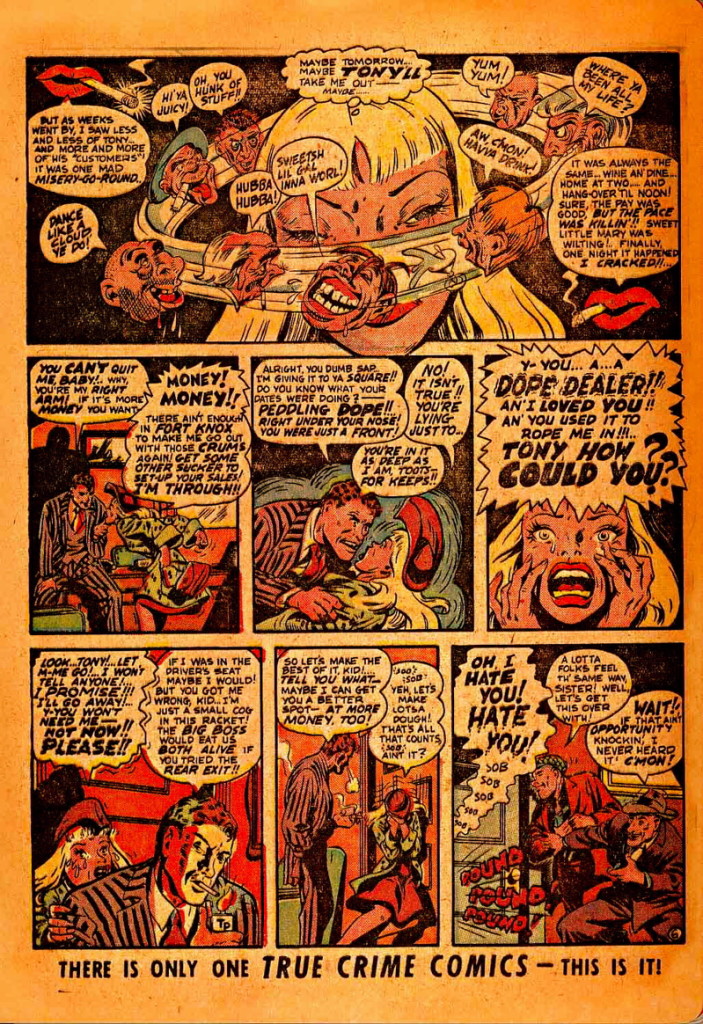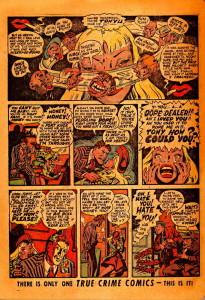I’m an avid reader of comics, clearly I love them because I’ve dedicated my livelihood to the medium. I’ve never considered myself a feminist and I’ve never been passionate about any gender-equality discussions I’ve had, but I must admit after reading Jack Cole’s 1947 True Crime #2 story titled “Murder, Morphine, and Me” I may have to get in line to becoming active in the Feminist movement for the accurate portrayal of women in the media. It should be noted that this one-page story was a hot-bed of controversy of the time and could have fueled the writing of book such as Seduction of the Innocent. As a father of three, I will admit I would not want my children to read books with this type of objectification of women. Here is the original page:
(to see the image larger so you can read it: http://www.mediafire.com/view/7ebwuajf1a5jocv/comics_First_Essay,_Jack_Cole.jpg)
I’m taking a course on Comics and Graphic Novels through the University of Colorado Boulder and wrote this essay. I take a rather strong position more so than I normally would, but I feel it has merit.
In reviewing the infamous page of Jack Cole’s True Crime #2 from 1947 titled “Murder, Morphine and Me” we come to see what Fredric Wertham was concerned about in his book, Seduction of the Innocent indeed had merit in that this comic glorifies crime, drug abuse and the abuse of women. Whether the reader is nine or ninety the tone and themes of this story insidiously promote the inferiority of women.
Let’s first start off with the title of the book and story, True Crime suggests that as the reader purchased this four-colored work of fiction that perhaps it is based on reality. Was this a documentary in the making in the eyes of a young reader? Would little Timmy be peeking back behind the curtain of journalism from the black and white CBS channel to discover the “real” newsworthy stories in this comic? I would say that the title if nothing else hints that yes this is a book filled with real stories and hits harder and more visceral because of it. Even if this is clearly made for entertainment, because it’s “true” perhaps this is the way women are treated in the world. The title of this one page “Murder, Morphine and Me” clearly relates to the story, but we do not see murder or morphine directly. The term dope is used in the dialog, but at the time this could be referring to a number of illicit drugs, and I would argue that the decision on the title would be for alliterative purposes. This choice may also guide our young reader to learn about the word morphine as it was not used in the common vernacular, so this research for definition and understanding could unlock even more treacherous paths for young Timmy.
The story opens up to a sexual image of red lips with a dangling cigarette and told is flashback. We see from this wide and large panel taking up 1/3 of the page that this is the image to focus on, the wonderfully rendered “Misery-go-round”. We know it’s flashback from the dialog and the worn and tired lips suggest that this is now old hat, she has been “working” in this world of whoring and drug trafficking for some time. The men around her all in facial expressions of ecstasy, salivating at the indecent proposals or in mid-coitus. The large lettered word “TONY’LL” suggests that the main male character in the story has power and control over her fate. The dialog suggest she is nothing but a pawn and object to use, without autonomy and will, only to be acted upon and not to act.
In the second part of the story we meet Tony, he is handsome, well-formaldressed and powerful. When the female character, (who does not have a name, another form of objectification)
wishes to leave this world, she can not because she’s an accomplice to the crimes. This teaches that even the victims are guilty of these crimes. The lettering also overstates the power and strength of the words, Dope, Money and Tony. The female is given names like Toots, dumb sap, baby and kid; all terms to signify weakness, immaturity and ineptitude.
The third and final act of our story, which is the third set of panels introduces the futility of going against the path they are down. Even Tony can not escape the clutches of the big boss and the only consolation to be had is the promise of lucre. The nameless female relents to the proposal and changes her goal to simply making as much money as possible. The final panel solidifies the female’s horrific position by having her ineptly cry while there is pounding going on inside the room. Is this forced sex that Tony is now introducing into their twisted relationship or simply beating her? Either way, Tony is in the position of power and she an object to abused, sexually or physically. We also are introduced to two new voyeuristic characters, who make a joke about hearing the sobbing and pounding of flesh and see that as an opportunity to join in. Their smiles suggest it would be fun and pleasurable to help Tony out. Because we do not see what is happening behind closed doors, the reader can only imagine what horrors are occurring and that could be worse than the author may have even intended.
In conclusion, despite the powerful storytelling, the combination of words and art, or better said because of it, it is clear that this page exemplifies the objectification of women and glorifies their abuse. The story is banal and independent of the target audience, whether it be for children or adults, it shows that this woman is used as dross for monetary gain. Her powerlessness in the story is terrifying and ultimately while she does survive the story, according to the flashback on the first panel, she is now a shell of a human being with little motivation for a life course-correction and recalls this moment in her past with the clarity of a victim who replays it in her mind in the dark, quiet moments of life.

